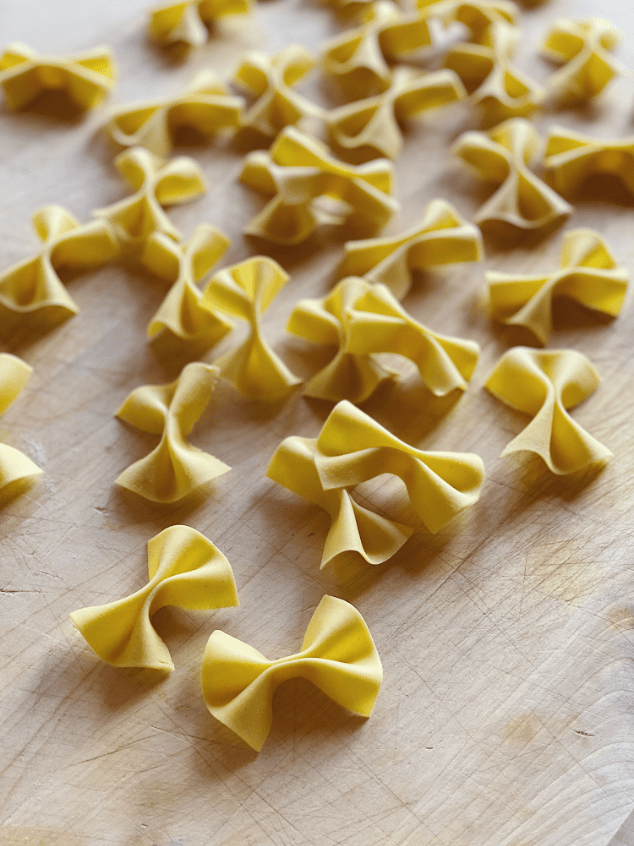Homemade Pasta Dough
If you were to ask me what meal I’d want before I die, I’d say pasta 100% of the time. Maybe it’s my Italian blood or just my love for carbs but either way, pasta is my ride or die!
I distinctly remember “pasta week” in culinary school – one of the best weeks of class, by far (although I feel like I said that about pretty much every week!). I’ve always loved cooking but before culinary school, I hadn’t actually made pasta dough by hand. Let me tell you, it was love-at-first-egg-yolk-well and I immediately purchased my own pasta roller so I could recreate the dough at home. There’s something joy-inducing about making pasta from scratch and I was instantly hooked.
Fast forward to my restaurant externship at Octavia…one of my jobs each shift was making the pasta dough for service the following day. Most nights, I’d make upwards of 20 lbs of pasta dough – both squid ink and regular egg (see pic below!). Needless to say, I got reaallly strong forearms from all of the kneading. Something I learned at the restaurant is the power + efficiency of using a stand mixer to make pasta vs. mixing by hand. More on that in the next section!
A FEW NOTES + PASTA MAKING TIPS:
Using a Stand Mixer or Food Processor – I call for a stand mixer or a food processor to mix this dough. I know that all of the Nonnas out there might have my head for this but I find it to be the easiest, most efficient way to mix! You can also mix by hand if you prefer. Just make a well with the flour and salt and add the whisked wets to the center of the well. Whisk with a fork until thickened and use a bench scraper to help bring the final dough together.
Ingredients – Ultimately, there are TONS of different delicious pasta recipes out there and so many variations on ingredients and quantities. That’s because pasta dough is super forgiving – you can even make it out of just flour and water! I know this recipe likely calls for more ingredients than your average pasta dough, so I want to include a quick break-down of what each ingredient imparts in the dough:
00 Flour – this flour is used a lot in Italian cooking (you’ll mostly see it used in pasta and pizza dough). It’s milled very finely, so it results in a more delicate end product. That said, you can definitely use All Purpose flour in this recipe – it will also turn out great!
Egg Yolks – I like to use egg yolks because they add a really nice richness to the dough.
Whole Egg – The whole egg is important because the protein and water content in the egg whites help make the dough easier to work with and gives the final product it a bit more of a chew. I don’t use all whole eggs in this recipe because I like the richness of using mostly yolks.
Salt – The salt imparts flavor and it also helps strengthen the gluten in the flour. This helps get you that great structure + elasticity (you’ll notice it’s added in a small amount – too much and you’ll end up with excessive gluten development and a tough dough).
Milk and Oil – both of these are fat sources that impart richness and great flavor into the dough. They also aid in making a supple dough that’s easier to roll out.Resting is your friend – allowing the dough to rest and hydrate after you mix (step 5) and after you knead (step 7) is imperative. The hydration rest is key – since you’re working with a dryer dough, you need to give the flour some time to absorb the wet ingredients. Resting after kneading is equally important – it relaxes the gluten network you just formed when kneading the dough and makes it much more pliable, soft and easier to roll out. If you skip this step, your dough will be too tight and will break apart + lump when you try to roll it out.
Plastic wrap – It’s very important to wrap your dough with plastic wrap when you aren’t working with it (i.e. wrapping the dough when you rest it in steps 5 and 7 and wrapping any dough you aren’t rolling out). It will dry out super fast on you!
MY FAVORITE PASTA MAKING TOOLS
FRESH PASTA DOUGH RECIPE
Makes ~ 1 lb. pasta
INGREDIENTS
1 whole egg + 7 yolks from large eggs
2 Tbsp whole milk
2.5 tsp Extra Virgin Olive Oil
2 cups 00 Flour (can use All Purpose too)
3/4 tsp kosher salt
Semolina flour for dusting
METHOD
1. In a stand mixer with the paddle attachment or using a food processor, mix the egg + egg yolks, milk and olive oil until the mixture is homogeneous.
2. Add in the flour and salt and mix just until the dough comes together. Your dough should be slightly tacky but if it is sticky to the touch, add more flour, 1 Tbsp at a time. Climate can affect your dough, so some people may need to add more flour and other people will be just fine with 2 cups!
3. Once the dough has come together (there may be some dry spots still), it’s time to let it rest for 30 minutes at room temp, tightly wrapped in plastic wrap. This step is important in allowing the flour in the dough to hydrate.
4. After 30 minutes of resting, unwrap your dough…it’s time to knead! Fold the dough over itself and push it against the board and away from you, rotating it each time you do this. Knead for about 5 minutes total, or until the dough springs back when you poke it – this means a tight gluten network has formed. As you knead, you’ll notice the dough will hydrate even more and any potential dry spots will disappear.
5. Wrap the dough tightly in plastic wrap and allow it to rest 15 minutes at room temp. This step is crucial to allow the tight gluten networks we just formed to relax. At this point, you can also store in the fridge overnight (i like to tightly wrap in plastic and then also put into a bag or container to prevent drying out). I’ve found that any longer than a day in the fridge and the dough will start to oxidize (will turn almost a light green color).
6. Unwrap your dough and portion it into thirds. Take one third of the dough out and tightly wrap the other two in plastic wrap. Use a rolling pin or the heel of your hands to press the dough ball into a flat disk – you want to aim for 1/4 inch so that it will easily feed into your pasta machine.
7. Time to roll out! Lightly dust both sides of the dough with semolina or 00 flour to prevent sticking to the pasta machine. Turn your pasta machine dial to the widest setting. On my machine, that is a “1.” With your machine running (or while cranking), feed the dough in and allow it to pass through. Then, fold the dough over itself in thirds like a letter and press down. Then, feed through on the same setting again. Continue this folding + passing process 6-8 times until your dough is nice and smooth.
8. Now, you’re done laminating the dough! Time to roll it out into a thin sheet. Turn the dial on your pasta machine one notch thinner – for me this is a “2.” Pass through once. Continue to do this – turning the dial on your machine one notch and passing the dough through once at each setting. Do this until your pasta is “as thin as a successful person’s business card,” as our chef instructor at culinary school used to say…lol.
Your dough should be thin enough where you can faintly see your hand underneath it but not paper thin. For me, this is a “7” setting but it could be different on your machine. NOTE: if you’re making a filled pasta (i.e. ravioli tortellini, etc.), I recommend going one setting thinner. Since you’re folding the pasta on top of itself for a stuffed pasta, you want the sheets to be a bit thinner to begin with.
9. Now that you’ve rolled out your dough, you can set aside on a sheet tray lined with a little semolina flour (or 00/AP flour) to prevent sticking. I also put a little dusting of said flour between the layers of stacked pasta sheets. Cover the sheet tray loosely with plastic wrap.
10. Repeat steps 9-11 with the remaining two pieces of dough.
11. From here, you can cut your sheets of rolled out dough into long noodles or make fun shapes! I love watching this video for pasta shaping inspiration! Skip to 8:07 for pastas made with this type of dough!
12. Either cook the pasta right away in a large pot of well-salted, boiling water or store for another time!
If you’re cooking it right away, please note that since this is fresh pasta, it will cook really quickly – in about 2 minutes. Definitely keep an eye on it!
I like to make a batch of pasta and freeze it because you can cook it from frozen whenever you want. To freeze, lay the pasta in an even layer on a parchment-lined sheet tray and transfer to the freezer, uncovered, Allow it to stiffen up for about an hour. Remove the sheet tray and transfer the hardened pasta to an airtight container (you can stack the pasta on top of it’s self since it’s now frozen). Return to the freezer and store there until you want to use it.









